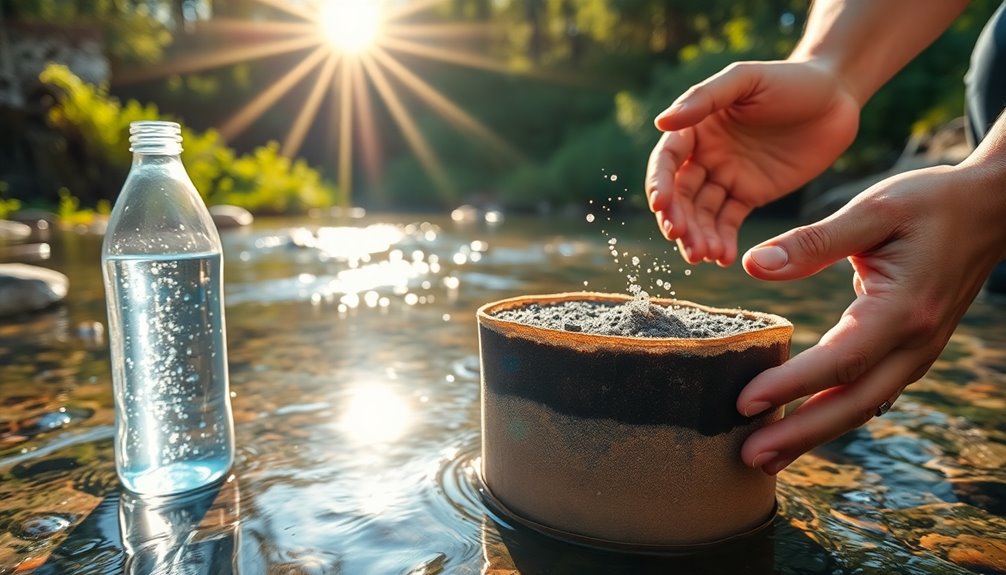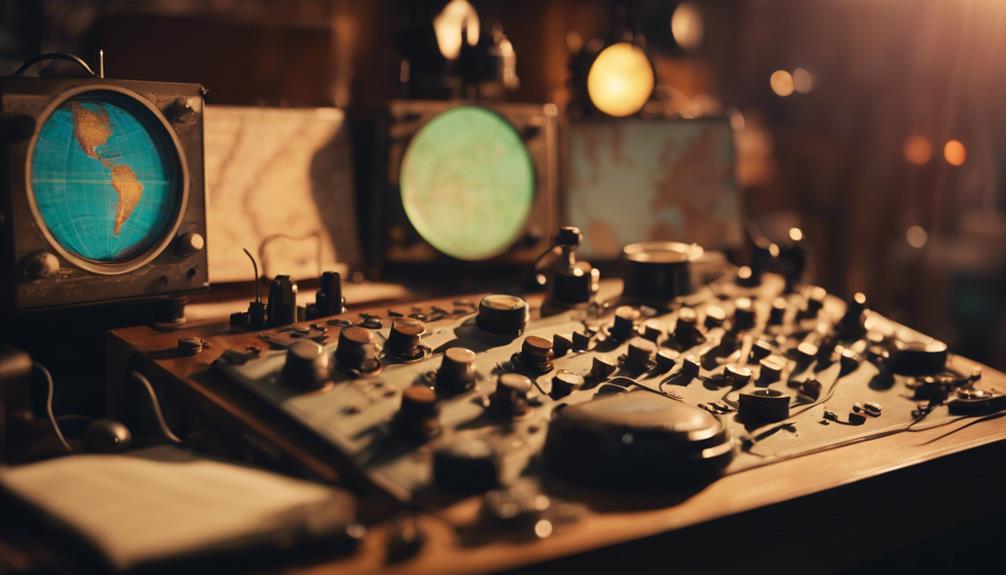Purifying water is an essential skill that can keep you safe from harmful pathogens and toxins. You can start by boiling water, which effectively kills most germs, making it ideal during emergencies. Chemical treatments like chlorination provide quick purification, while advanced methods like UV purification and reverse osmosis offer high-level filtration. Using mechanical and adsorptive filters can enhance taste and remove larger impurities. Each method has its strengths and weaknesses, so knowing when to use them is key. Discovering the best techniques can empower you with the knowledge to guarantee safe drinking water anytime.
Key Takeaways
- Boil water for at least one minute to kill most pathogens; extend boiling time at higher altitudes for safety.
- Use chlorine treatment to quickly eliminate bacteria and viruses; monitor residual chlorine levels to prevent regrowth.
- Implement UV purification to effectively kill up to 99.99% of germs without harmful chemical residues; pre-treat for turbidity.
- Consider reverse osmosis for high purity levels, removing salts and microorganisms, but be aware of potential wastewater production.
- Combine multiple methods, like filtration and chemical treatments, for comprehensive water purification and enhanced safety.
Importance of Water Purification

In today's world, the importance of water purification can't be overstated. Safe drinking water is essential for your overall health and well-being. By removing harmful bacteria, viruses, parasites, and fungi, water purification helps prevent diseases like diarrhea, cholera, and typhoid. It also eliminates carcinogenic chemicals, reducing your risk of serious health issues. You'll feel more at ease knowing that you're not exposed to contaminants like chlorine, which can cause irritation and breathing difficulties.
Moreover, water purification protects against lead poisoning, a serious concern that can lead to learning disorders in children. This is especially vital for vulnerable populations. In fact, 52% of filtration owners trust tap water at home, highlighting the need for effective purification solutions.
On a broader scale, water purification plays a significant role in environmental conservation. It reduces reliance on single-use plastic bottles, which take centuries to decompose and pollute our planet. By making tap water safe, you can help minimize waste and promote sustainable practices.
With a growing global need for clean water—2.1 billion people lack safe drinking water—your choice to purify can make a significant impact. Embracing water purification isn't just about personal health; it's a step towards a healthier planet.
Boiling: A Simple Solution
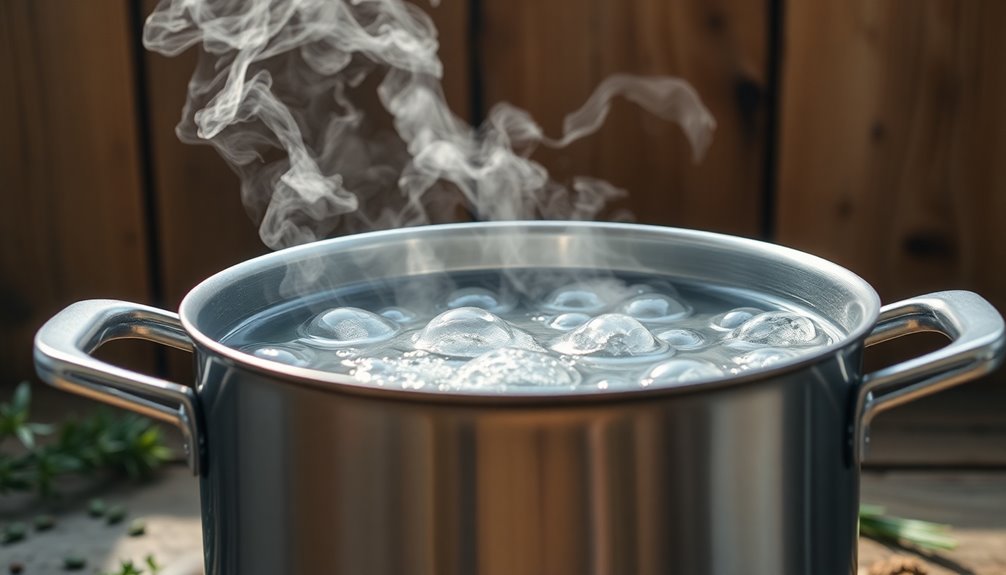
Boiling water is one of the simplest and most effective methods for purifying your drinking supply. By bringing water to a rolling boil, you can kill most bacteria, viruses, and parasites, making it essential in emergencies or remote areas where clean water is scarce. Just remember, at higher altitudes, you'll need to extend the boiling time to guarantee all pathogens are eliminated. Boil your water until you see the first big bubbles for maximum safety.
However, boiling has its limitations. It won't remove chemical pollutants, heavy metals, or toxins like lead, mercury, and pesticides. In fact, boiling can concentrate these contaminants, potentially making the water more hazardous. Physical impurities such as dirt or sediment also remain, and the taste may even suffer as dissolved oxygen decreases. Additionally, boiling requires time and energy, which can make it less sustainable in the long run. It might reduce your water supply due to evaporation, and handling hot water poses burn risks. While boiling is effective for immediate safety, be aware of its drawbacks and consider alternative purification methods for thorough water treatment. Moreover, to ensure the highest level of safety, it is crucial to integrate multiple purification methods, as comprehensive systems can address the limitations of boiling.
Effective Filtration Techniques
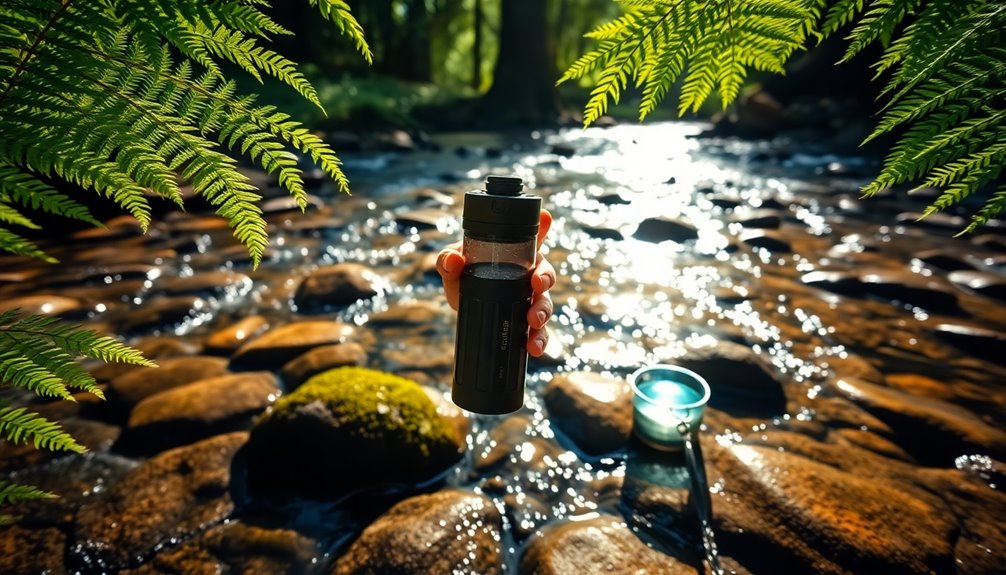
Effective filtration techniques can greatly improve the quality of your drinking water by removing harmful contaminants. One powerful method is membrane filtration, which uses high pressure to push water through membranes with tiny pores. This approach effectively filters out bacteria, viruses, and suspended solids, with ultrafiltration membranes capable of capturing particles as small as 0.01 microns. Membrane filtration is ideal for industries requiring contaminant-free water, such as beverage production.
Another effective technique is adsorptive media filtration, which employs materials like activated carbon to trap contaminants. This method excels at removing chlorine and volatile organic compounds (VOCs), enhancing the taste and odor of your water. Just remember, activated carbon filters need regular replacement due to their limited lifespan.
You can also explore physical filtration methods, such as rapid and slow sand filtration. Rapid sand filtration combines sand and activated carbon to eliminate suspended particles, while slow sand filtration utilizes biological processes for effective water treatment. Mechanical filters play a role too, removing dirt and sediment.
The Power of Distillation
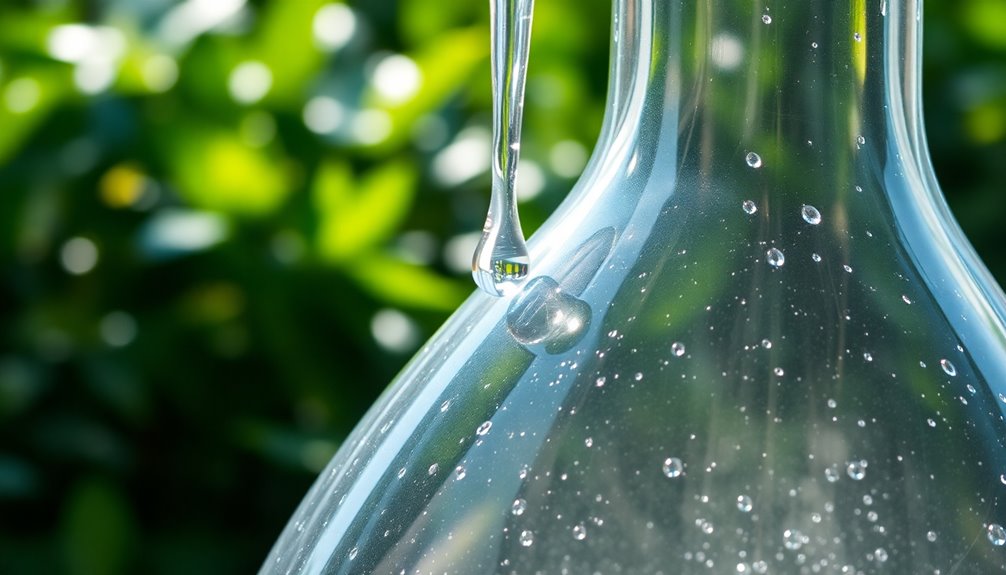
Distillation stands out as one of the most efficient methods for purifying water, leveraging the natural process of evaporation to eliminate contaminants. By heating contaminated water, you generate steam, leaving behind inorganic compounds and large non-volatile organic molecules. As the steam cools and condenses, it transforms back into liquid water, effectively removing many impurities and killing harmful microorganisms. It is essential to ensure proper condenser water flow for optimal vapor trapping during this process.
Here's a quick overview of distillation:
| Component | Function | Notes |
|---|---|---|
| Boiling Chamber | Heats water to create steam | Temperature control is essential for efficiency |
| Condensing Coils | Cools steam to form purified water | Must be kept clean for maximum performance |
| Storage Tank | Holds the distilled water | Regular maintenance is critical |
While distillation can remove up to 99.5% of impurities, it's significant to highlight that some volatile organic compounds may vaporize and re-contaminate the purified water. Regular maintenance, including cleaning and flushing out pollutants, is crucial to keep your distillation unit running smoothly. Overall, distillation is a powerful tool in your water purification arsenal.
Chlorination for Quick Purification
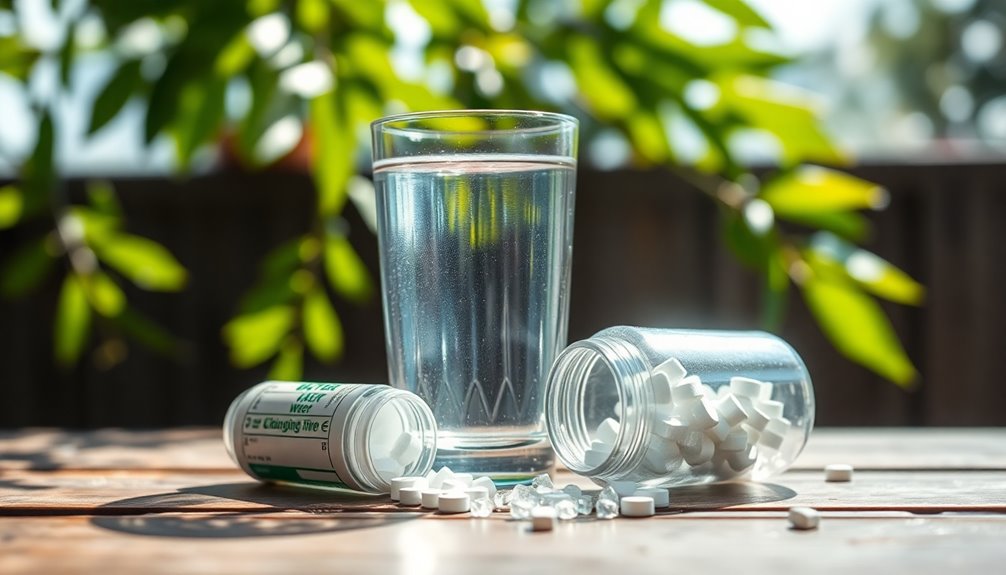
When you need a fast and effective solution for water purification, chlorination is a reliable method that quickly eliminates pathogens. You can choose from different types, including batch disinfection for emergencies or simple chlorination, which maintains a low level of free chlorine to guarantee safety. For rapid results, super-chlorination offers higher concentrations, drastically cutting down the necessary contact time.
Chlorine comes in various forms. You might use chlorine gas, sodium hypochlorite, or calcium hypochlorite, depending on your situation. If you're dealing with persistent bacteria or slime, shock chlorination can effectively kill those unwanted organisms. It's important to maintain a residual chlorine level to prevent pathogen regrowth, making sure your water stays safe long after treatment. This effectiveness is influenced by factors such as pH, temperature, and chlorine level, which must be carefully monitored for optimal results.
However, while chlorination is cost-effective and simple, be aware of potential by-products like trihalomethanes, which can be harmful. Regular monitoring of chlorine levels is essential for successful purification. Overall, chlorination not only improves water quality but also provides peace of mind in emergency situations, making it a significant skill for anyone looking to guarantee safe drinking water.
UV Purification: A Modern Approach
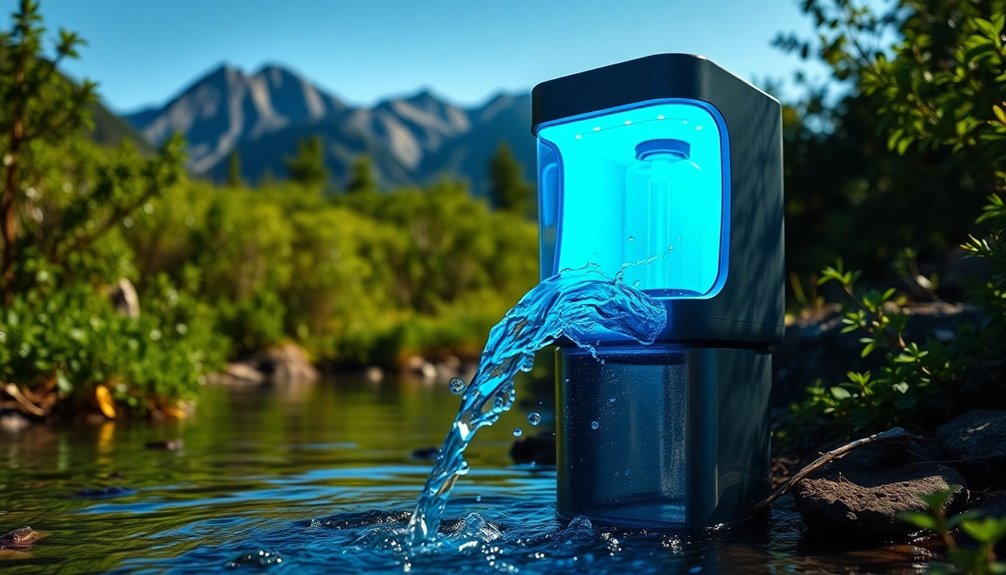
Harnessing the power of ultraviolet (UV) light, UV purification offers a cutting-edge solution for disinfecting water without the use of chemicals. This method employs UV light at a wavelength of 254 nm to penetrate microorganisms' cells, altering their DNA and preventing reproduction. The process is straightforward: pre-treated water flows into a stainless steel chamber, passes around a UV lamp, and exits as clean, treated water.
The effectiveness is remarkable, killing up to 99% of germs in under 10 seconds. Plus, UV purification is environmentally friendly, leaving no harmful chemical residues and maintaining the water's taste, odor, and pH. Additionally, it is important to note that UV purification systems are designed to eliminate 99.99% of harmful microorganisms, ensuring a high level of safety in drinking water.
However, you should be aware that UV systems don't remove particles or contaminants like heavy metals or pesticides. Pre-treatment is often necessary to eliminate turbidity and organic matter that could interfere with UV light. Installation is simple, whether you choose a point-of-use or point-of-entry system, and with no moving parts, maintenance is minimal. Just remember to replace the UV lamp annually for ongoing effectiveness. With these advantages, UV purification is a smart choice for ensuring safe drinking water.
Reverse Osmosis Explained

How does reverse osmosis deliver such pure water? This advanced purification process uses a semi-permeable membrane to filter out unwanted molecules and large particles. By forcing water through this membrane under high pressure, it effectively removes contaminants, achieving purity levels that can reach up to 99%.
In reverse osmosis, water molecules pass through the membrane while larger impurities like salts, minerals, and microorganisms get left behind. The system typically involves multiple stages, including pre-filters to catch larger particles, the RO membrane itself, and post-filters to polish the water. The result is purified water, known as permeate, while the concentrated contaminants are discharged. Additionally, the process requires the application of excess pressure to overcome osmotic pressure, ensuring effective separation of solutes.
This method isn't just effective; it's versatile too. You can use reverse osmosis for desalinating seawater, treating liquid wastes, or ensuring safe drinking water. Plus, RO systems are compact, making them ideal for home use. With regular maintenance, including periodic sterilization, you can keep your system contamination-free. Ultimately, reverse osmosis brings you water quality that approaches that of distilled water, ensuring you have safe, clean water to drink.
Frequently Asked Questions
How Can I Tell if My Water Is Contaminated?
To tell if your water's contaminated, look for unusual colors like brown or green, or a cloudy appearance. Notice any unpleasant odors, such as sewage or rotten eggs, and check for a metallic taste. Watch for floating debris or excessive algae blooms, which may indicate nutrient overload. Pay attention to any suspicious discharges and infrastructure issues, like low water pressure or visible sediment. If you spot these signs, it's best to get your water tested.
What Is the Shelf Life of Water Purification Tablets?
The shelf life of water purification tablets varies based on their type. Chlorine-based and NaDCC tablets last about 4-5 years unopened, while iodine tablets can last indefinitely if stored properly. Once opened, most tablets, including chlorine and NaDCC, remain effective for a year. Silver tablets can last up to 10 years unopened. Always check expiration dates and store them in a cool, dry place to maintain their effectiveness.
Can I Use Dish Soap to Purify Water?
No, you shouldn't use dish soap to purify water. It's not designed for that purpose and can actually introduce harmful chemicals, leaving behind residue that contaminates the water further. Dish soap won't kill bacteria or viruses either. Instead, focus on effective methods like boiling, chemical disinfection, or using UV light purifiers. These methods guarantee safe drinking water without the risks associated with using dish soap. Always prioritize safe practices for purification.
Is Rainwater Safe to Drink Without Purification?
Rainwater isn't safe to drink without purification. It can contain harmful contaminants like bacteria, viruses, and toxic chemicals from the atmosphere. Even if it looks clear, it may still carry pollutants that can cause illness. You should always treat rainwater before consumption. Consider filtering, disinfecting, and regularly testing the water to guarantee it's safe. Taking these precautions helps protect your health and ensures you're drinking clean water.
What Are the Signs of Waterborne Illnesses?
Waterborne illnesses can feel like a hidden storm, brewing silently before it strikes. If you experience symptoms like diarrhea, nausea, or abdominal pain, it's a sign you might be dealing with contaminated water. You could also notice fatigue, fever, or skin rashes. In severe cases, watch for profuse diarrhea or respiratory issues, which could indicate a more serious infection. Stay vigilant; these symptoms signal your body's distress from harmful pathogens.
Conclusion
In a world where clean water can feel like a treasure buried deep, mastering these purification techniques is your key to survival. By boiling, filtering, or harnessing the sun’s rays, you’re not just quenching your thirst; you’re safeguarding your health. Picture yourself as a modern-day alchemist, transforming murky water into life-giving elixirs. Embrace these hacks, and you’ll navigate the waters of uncertainty with confidence, ensuring you and your loved ones always have access to pure, safe water. Additionally, knowing how to find water in the wild is a crucial skill to have in your survival toolkit. By learning to identify signs of water sources such as animal tracks, vegetation, or low-lying areas, you’ll be better equipped to locate this precious resource in times of need. Combine this knowledge with effective purification techniques, and you’ll have the confidence to thrive in any environment, no matter how challenging. So, don’t just survive – thrive by mastering the art of finding and purifying water in any situation.

